#Thiel One Foot in Front of the Other
Explore tagged Tumblr posts
Text
Canada Road 4

AUGUST 23
Aug 21 23
Between Goderich and Kincardine,
Lake Huron
Great Lakes
Ontario
Sunset 30 minutes ago
We ate and swam today. I t was a cold night and we awoke thinking we needed sweaters, but the cloud cover disappeared and it was sunny. So, we visited the Zehrs, the Dollar store, and the Walmart to do our shopping and there was acres and acres of stuff. I cannot believe the size of the shop and even the size of the vegetables, big. And so many of my old favourites like Bran Muffins, Corn Bread and Blueberry pancakes with maple syrup.

Then we had visitors who had driven three hours to see us. Old friends and relatives from fifty years ago. So, we swam in the shiny water, used the kayak and watched the shore from the water.

It is very green and leafy, trees everywhere you look and driftwood gets washed up and next door there are driftwood sculptures on the beachfront. Then we sat under an awning on the beach and some people collected rocks.

Dinner was cooked on skewers on the Bar B Q by new friend and children swung in the hammock, bright coloured hanging from the two nearby trees.

They had to leave early to drive three hours back again and we got to watch the sunset which was slow and took many stages partly behind clouds and then appearing from behind grey clouds to turn the water silver for a moment before finally disappearing behind the lowest band of grey cloud and night quietly falls.

www.lynnepearl.com
0 notes
Photo

“Entrepreneurship: you put one dumb foot in front of the other while the world throws bricks at your head.”
– Peter Thiel
Read more adversity quotes here: https://spreadgreatideas.org/quotes/quotes-adversity/
0 notes
Text
5 cuốn sách về khởi nghiệp trong thời đại 4.0 anh em nên đọc

Năm 2020 sắp đến, sắp thêm tuổi mới, vậy mình đọc sách gì cho chín chắn hơn chút nhỉ? Tôi xin giới thiệu với anh em 7 tựa sách hay anh em nên đ��c trong thời gian còn lại của năm 2019.
1. The Inevitable: Understanding the 12 Technological Forces That Will Shape Our Future
From one of our leading technology thinkers and writers, a guide through the twelve technological imperatives that will shape the next thirty years and transform our lives
Much of what will happen in the next thirty years is inevitable, driven by technological trends that are already in motion. In this fascinating, provocative new book, Kevin Kelly provides an optimistic road map for the future, showing how the coming changes in our lives—from virtual reality in the home to an on-demand economy to artificial intelligence embedded in everything we manufacture—can be understood as the result of a few long-term, accelerating forces. Kelly both describes these deep trends—flowing, screening, accessing, sharing, filtering, remixing, tracking, and questioning—and demonstrates how they overlap and are codependent on one another. These larger forces will completely revolutionize the way we buy, work, learn, and communicate with each other. By understanding and embracing them, says Kelly, it will be easier for us to remain on top of the coming wave of changes and to arrange our day-to-day relationships with technology in ways that bring forth maximum benefits. Kelly’s bright, hopeful book will be indispensable to anyone who seeks guidance on where their business, industry, or life is heading—what to invent, where to work, in what to invest, how to better reach customers, and what to begin to put into place—as this new world emerges.
2. Platform Revolution: How Networked Markets Are Transforming the Economy and How to Make Them Work for You
Uber. Airbnb. Amazon. Apple. PayPal. All of these companies disrupted their markets when they launched. Today they are industry leaders. What’s the secret to their success?
These cutting-edge businesses are built on platforms: two-sided markets that are revolutionizing the way we do business. Written by three of the most sought-after experts on platform businesses, Platform Revolution is the first authoritative, fact-based book on platform models. Whether platforms are connecting sellers and buyers, hosts and visitors, or drivers with people who need a ride, Geoffrey G. Parker, Marshall W. Van Alstyne, and Sangeet Paul Choudary reveal the what, how, and why of this revolution and provide the first “owner’s manual” for creating a successful platform business.
Platform Revolution teaches newcomers how to start and run a successful platform business, explaining ways to identify prime markets and monetize networks. Addressing current business leaders, the authors reveal strategies behind some of today’s up-and-coming platforms, such as Tinder and SkillShare, and explain how traditional companies can adapt in a changing marketplace. The authors also cover essential issues concerning security, regulation, and consumer trust, while examining markets that may be ripe for a platform revolution, including healthcare, education, and energy.
As digital networks increase in ubiquity, businesses that do a better job of harnessing the power of the platform will win. An indispensable guide, Platform Revolution charts out the brilliant future of platforms and reveals how they will irrevocably alter the lives and careers of millions.
3. Running Lean: Iterate from Plan A to a Plan That Works
We live in an age of unparalleled opportunity for innovation. We’re building more products than ever before, but most of them fail—not because we can’t complete what we set out to build, but because we waste time, money, and effort building the wrong product.
What we need is a systematic process for quickly vetting product ideas and raising our odds of success. That’s the promise of Running Lean.
In this inspiring book, Ash Maurya takes you through an exacting strategy for achieving a "product/market fit" for your fledgling venture, based on his own experience in building a wide array of products from high-tech to no-tech. Throughout, he builds on the ideas and concepts of several innovative methodologies, including the Lean Startup, Customer Development, and bootstrapping.
Running Lean is an ideal tool for business managers, CEOs, small business owners, developers and programmers, and anyone who’s interested in starting a business project.
Find a problem worth solving, then define a solution Engage your customers throughout the development cycle Continually test your product with smaller, faster iterations Build a feature, measure customer response, and verify/refute the idea Know when to "pivot" by changing your plan’s course Maximize your efforts for speed, learning, and focus Learn the ideal time to raise your "big round" of funding
Get on track with The Lean Series Presented by Eric Ries—bestselling author of The Lean Startup: How Today’s Entrepreneurs Use Continuous Innovation to Create Radically Successful Businesses—The Lean Series gives you solid footing in a proven methodology that will help your business succeed.
4. The Lean Startup: How Today's Entrepreneurs Use Continuous Innovation to Create Radically Successful Businesses
Most startups fail. But many of those failures are preventable. The Lean Startup is a new approach being adopted across the globe, changing the way companies are built and new products are launched.
Eric Ries defines a startup as an organization dedicated to creating something new under conditions of extreme uncertainty. This is just as true for one person in a garage or a group of seasoned professionals in a Fortune 500 boardroom. What they have in common is a mission to penetrate that fog of uncertainty to discover a successful path to a sustainable business.
The Lean Startup approach fosters companies that are both more capital efficient and that leverage human creativity more effectively. Inspired by lessons from lean manufacturing, it relies on “validated learning,” rapid scientific experimentation, as well as a number of counter-intuitive practices that shorten product development cycles, measure actual progress without resorting to vanity metrics, and learn what customers really want. It enables a company to shift directions with agility, altering plans inch by inch, minute by minute.
Rather than wasting time creating elaborate business plans, The Lean Startup offers entrepreneurs - in companies of all sizes - a way to test their vision continuously, to adapt and adjust before it’s too late. Ries provides a scientific approach to creating and managing successful startups in a age when companies need to innovate more than ever.
5. Zero to One: Notes on Startups, or How to Build the Future
If you want to build a better future, you must believe in secrets.
The great secret of our time is that there are still uncharted frontiers to explore and new inventions to create. In Zero to One, legendary entrepreneur and investor Peter Thiel shows how we can find singular ways to create those new things.
Thiel begins with the contrarian premise that we live in an age of technological stagnation, even if we’re too distracted by shiny mobile devices to notice. Information technology has improved rapidly, but there is no reason why progress should be limited to computers or Silicon Valley. Progress can be achieved in any industry or area of business. It comes from the most important skill that every leader must master: learning to think for yourself.
Doing what someone else already knows how to do takes the world from 1 to n, adding more of something familiar. But when you do something new, you go from 0 to 1. The next Bill Gates will not build an operating system. The next Larry Page or Sergey Brin won’t make a search engine. Tomorrow’s champions will not win by competing ruthlessly in today’s marketplace. They will escape competition altogether, because their businesses will be unique.
Zero to One presents at once an optimistic view of the future of progress in America and a new way of thinking about innovation: it starts by learning to ask the questions that lead you to find value in unexpected places.
6. Machine, Platform, Crowd: Harnessing Our Digital Future
We live in strange times. A machine plays the strategy game Go better than any human; upstarts like Apple and Google destroy industry stalwarts such as Nokia; ideas from the crowd are repeatedly more innovative than corporate research labs.
MIT’s Andrew McAfee and Erik Brynjolfsson know what it takes to master this digital-powered shift: we must rethink the integration of minds and machines, of products and platforms, and of the core and the crowd. In all three cases, the balance now favors the second element of the pair, with massive implications for how we run our companies and live our lives.
In the tradition of agenda-setting classics like Clay Christensen’s The Innovator’s Dilemma, McAfee and Brynjolfsson deliver both a penetrating analysis of a new world and a toolkit for thriving in it. For startups and established businesses, or for anyone interested in what the future holds, Machine, Platform, Crowd is essential reading.
7. Connected: The Surprising Power of Our Social Networks and How They Shape Our Lives
Celebrated scientists Nicholas Christakis and James Fowler explain the amazing power of social networks and our profound influence on one another's lives. Your colleague's husband's sister can make you fat, even if you don't know her. A happy neighbor has more impact on your happiness than a happy spouse. These startling revelations of how much we truly influence one another are revealed in the studies of Drs. Christakis and Fowler, which have repeatedly made front-page news nationwide.
In CONNECTED, the authors explain why emotions are contagious, how health behaviors spread, why the rich get richer, even how we find and choose our partners. Intriguing and entertaining, CONNECTED overturns the notion of the individual and provides a revolutionary paradigm-that social networks influence our ideas, emotions, health, relationships, behavior, politics, and much more. It will change the way we think about every aspect of our lives.
8. The Second Machine Age: Work, Progress, and Prosperity in a Time of Brilliant Technologies
In recent years, Google’s autonomous cars have logged thousands of miles on American highways and IBM’s Watson trounced the best human Jeopardy! players. Digital technologies—with hardware, software, and networks at their core—will in the near future diagnose diseases more accurately than doctors can, apply enormous data sets to transform retailing, and accomplish many tasks once considered uniquely human. In The Second Machine Age MIT’s Erik Brynjolfsson and Andrew McAfee—two thinkers at the forefront of their field—reveal the forces driving the reinvention of our lives and our economy. As the full impact of digital technologies is felt, we will realize immense bounty in the form of dazzling personal technology, advanced infrastructure, and near-boundless access to the cultural items that enrich our lives.
Amid this bounty will also be wrenching change. Professions of all kinds—from lawyers to truck drivers—will be forever upended. Companies will be forced to transform or die. Recent economic indicators reflect this shift: fewer people are working, and wages are falling even as productivity and profits soar.
Drawing on years of research and up-to-the-minute trends, Brynjolfsson and McAfee identify the best strategies for survival and offer a new path to prosperity. These include revamping education so that it prepares people for the next economy instead of the last one, designing new collaborations that pair brute processing power with human ingenuity, and embracing policies that make sense in a radically transformed landscape.
A fundamentally optimistic book, The Second Machine Age alters how we think about issues of technological, societal, and economic progress.
9. The Fourth Industrial Revolution
Ob selbstfahrende Autos, 3-D-Drucker oder Künstliche Intelligenz: Aktuelle technische Entwicklungen werden unsere Art zu leben und zu arbeiten grundlegend verändern. Die Vierte Industrielle Revolution hat bereits begonnen. Ihr Merkmal ist die ungeheuer schnelle und systematische Verschmelzung von Technologien, die die Grenzen zwischen der physischen, der digitalen und der biologischen Welt immer stärker durchbrechen. Wie kein anderer ist Klaus Schwab, der Vorsitzende des Weltwirtschaftsforums, in der Lage aufzuzeigen, welche politischen, wirtschaftlichen, sozialen und kulturellen Herausforderungen diese Revolution für uns alle mit sich bringt.
10. Exponential Organizations: Why new organizations are ten times better, faster, and cheaper than yours (and what to do about it)
"EXPONENTIAL ORGANIZATIONS should be required reading for anyone interested in the ways exponential technologies are reinventing best practices in business.”—Ray Kurwzeil, Director of Engineering at Google
In business, performance is key. In performance, how you organize can be the key to growth.
In the past five years, the business world has seen the birth of a new breed of company—the Exponential Organization—that has revolutionized how a company can accelerate its growth by using technology. An ExO can eliminate the incremental, linear way traditional companies get bigger, leveraging assets like community, big data, algorithms, and new technology into achieving performance benchmarks ten times better than its peers.
Three luminaries of the business world—Salim Ismail, Yuri van Geest, and Mike Malone—have researched this phenomenon and documented ten characteristics of Exponential Organizations. Here, in EXPONENTIAL ORGANIZATIONS, they walk the reader through how any company, from a startup to a multi-national, can become an ExO, streamline its performance, and grow to the next level.
“EXPONENTIAL ORGANIZATIONS is the most pivotal book in its class. Salim examines the future of organizations and offers readers his insights on the concept of Exponential Organizations, because he himself embodies the strategy, structure, culture, processes, and systems of this new breed of company.”—John Hagel, The Center for the Edge
11. The Innovator's Solution: Creating and Sustaining Successful Growth
In his international bestseller The Innovator's Dilemma, Clayton M. Christensen exposed this crushing paradox behind the failure of many industry leaders: by placing too much focus on pleasing their most profitable customers, these firms actually paved the way for their own demise by ignoring the disruptive technologies that aggressively evolved to displace them. In The Innovator’s Solution, Christensen and coauthor Michael E. Raynor help all companies understand how to become disruptors themselves.
Clay Christensen (author of the award-winning Harvard Business Review article, “How Will You Measure Your Life?”) and Raynor not only reveal that innovation is more predictable than most managers have come to believe, they also provide helpful advice on the business decisions crucial to truly disruptive growth. Citing in-depth research and theories tested in hundreds of companies across many industries, the authors identify the processes that create successful innovation—and they show managers how to tailor their strategies to the changing circumstances of a dynamic world.
The Innovator’s Solution is an important addition to any innovation library.
Published by Harvard Business Review Press.
12. The Startup Way: How Modern Companies Use Entrepreneurial Management to Transform Culture and Drive Long-Term Growth
Bestselling author, entrepreneur, and Lean startup founder Eric Ries, author of The Lean Startup, reveals how established corporations and major enterprises can use Lean Startup techniques, energy and saavy to reinvigorate their company and operations, spark innovation, and drive growth. In The Lean Startup, Eric Ries, entrepreneur in residence at Harvard, serial entrepreneur and founder of the lean startup meetups, showed how ideas from the startup world such as constant iteration, minimal viable products (or MVPS), and constantly testing business hypotheses with customers to determine when to perservere, and when to pivot, now turns his attention to established, mature companies and organizations. For the past four years, Ries has been working closely with companies like GE and Toyota and Pitney Bowes to help them become more nimble, and more open to change and innovation, in order to spur growth and produce products and services that customers want. In The Startup Way, Ries shares his insights, lessons, stories, challenges and best practices from his intense collaborations with some of the world's most innovative and successful companies, as they attempt to change their culture and processes to be faster and smarter at what they do. At GE, Ries's ideas are codified under the name FastWorks; each company adapts his basic framework and ideas in their own way, to fit their particular organization and industry, as Ries discusses in the book. For every company that recognizes it needs to embrace agility, change and do so quickly if it is to survive and thrive, The Startup Way is an absolutely critical guide and toolkit.
13. Diffusion of Innovations
Now in its fifth edition, Diffusion of Innovations is a classic work on the spread of new ideas.
In this renowned book, Everett M. Rogers, professor and chair of the Department of Communication & Journalism at the University of New Mexico, explains how new ideas spread via communication channels over time. Such innovations are initially perceived as uncertain and even risky. To overcome this uncertainty, most people seek out others like themselves who have already adopted the new idea. Thus the diffusion process consists of a few individuals who first adopt an innovation, then spread the word among their circle of acquaintances—a process which typically takes months or years. But there are exceptions: use of the Internet in the 1990s, for example, may have spread more rapidly than any other innovation in the history of humankind. Furthermore, the Internet is changing the very nature of diffusion by decreasing the importance of physical distance between people. The fifth edition addresses the spread of the Internet, and how it has transformed the way human beings communicate and adopt new ideas.
14. Where Good Ideas Come from: The Natural History of Innovation
The printing press, the pencil, the flush toilet, the battery--these are all great ideas. But where do they come from? What kind of environment breeds them? What sparks the flash of brilliance? How do we generate the breakthrough technologies that push forward our lives, our society, our culture? Steven Johnson's answers are revelatory as he identifies the seven key patterns behind genuine innovation, and traces them across time and disciplines. From Darwin and Freud to the halls of Google and Apple, Johnson investigates the innovation hubs throughout modern time and pulls out the approaches and commonalities that seem to appear at moments of originality.
15. Blue Ocean Strategy: How to Create Uncontested Market Space and Make the Competition Irrelevant
The global phenomenon, embraced by business worldwide and now published in more than 40 languages.
This international bestseller challenges everything you thought you knew about the requirements for strategic success.
Since the dawn of the industrial age, companies have engaged in head-to-head competition in search of sustained, profitable growth. They have fought for competitive advantage, battled over market share, and struggled for differentiation. Yet, as this influential and immensely popular book shows, these hallmarks of competitive strategy are not the way to create profitable growth in the future.
In the international bestseller Blue Ocean Strategy, W. Chan Kim and Renee Mauborgne argue that cutthroat competition results in nothing but a bloody red ocean of rivals fighting over a shrinking profit pool. Based on a study of 150 strategic moves (spanning more than 100 years across 30 industries), the authors argue that lasting success comes not from battling competitors, but from creating "blue oceans"—untapped new market spaces ripe for growth. Such strategic moves, which the authors call “value innovation,” create powerful leaps in value that often render rivals obsolete for more than a decade.
Blue Ocean Strategy presents a systematic approach to making the competition irrelevant and outlines principles and tools any company can use to create and capture their own blue oceans. A landmark work that upends traditional thinking about strategy, this bestselling business book charts a bold new path to winning the future.
16. Smartcuts: How Hackers, Innovators, and Icons Accelerate Success
Entrepreneur and journalist Shane Snow (Wired, Fast Company, The New Yorker, and cofounder of Contently) analyzes the lives of people and companies that do incredible things in implausibly short time.
How do some startups go from zero to billions in mere months? How did Alexander the Great, YouTube tycoon Michelle Phan, and Tonight Show host Jimmy Fallon climb to the top in less time than it takes most of us to get a promotion? What do high-growth businesses, world-class heart surgeons, and underdog marketers do in common to beat the norm?
One way or another, they do it like computer hackers. They employ what psychologists call "lateral thinking: to rethink convention and break "rules" that aren't rules.
These are not shortcuts, which produce often dubious short-term gains, but ethical "smartcuts" that eliminate unnecessary effort and yield sustainable momentum. In Smartcuts, Snow shatters common wisdom about success, revealing how conventions like "paying dues" prevent progress, why kids shouldn't learn times tables, and how, paradoxically, it's easier to build a huge business than a small one.
From SpaceX to The Cuban Revolution, from Ferrari to Skrillex, Smartcuts is a narrative adventure that busts old myths about success and shows how innovators and icons do the incredible by working smarter—and how perhaps the rest of us can, too.
17. The Innovator's Dilemma
Harvard professor Clayton M. Christensen demonstrates in the most revolutionary business hook in years why outstanding companies that did everything right -- were in tune with the competition, listened to customers, and invested aggressively in new technologies -- still lost their market leadership when confronted with disruptive changes in technology and market structure...and he tells how to avoid a similar fate as business races online into the 21st century. The Innovator's Dilemma eloquently demonstrates a shattering paradox -- that the best of conventional good business practices can ultimately weaken a great firm. Over time, mainstream customers will initially reject important breakthroughs or disruptive technologies, leading firms to allow strategic innovations to languish. The solution? Create a subsidiary entirely focused on the emerging market, one that is free to be visionary while courting an unorthodox customer base and staying poised to catch the next great wave of industry growth. Sharp, cogent, and provocative, The Innovator's Dilemma is one of the most talked-about business books of our time -- and something that none of today's executives will dare to be without
18. The Innovator's Dilemma
Harvard professor Clayton M. Christensen says outstanding companies can do everything right and still lose their market leadership -- or worse, disappear completely. And he not only proves what he says, he tells others how to avoid a similar fate.
Focusing on "disruptive technology" -- the Honda Super Cub, Intel's 8088 processor, or the hydraulic excavator, for example -- Christensen shows why most companies miss "the next great wave." Whether in electronics or retailing, a successful company with established products will get pushed aside unless managers know when to abandon traditional business practices. Using the lessons of successes and failures from leading companies, "The Innovator's Dilemma" presents a set of rules for capitalizing on the phenomenon of disruptive innovation.
19. The Innovator's DNA: Mastering the Five Skills of Disruptive Innovators
A new classic, cited by leaders and media around the globe as a highly recommended read for anyone interested in innovation.
In The Innovator’s DNA, authors Jeffrey Dyer, Hal Gregersen, and bestselling author Clayton Christensen (The Innovator’s Dilemma, The Innovator’s Solution, How Will You Measure Your Life?) build on what we know about disruptive innovation to show how individuals can develop the skills necessary to move progressively from idea to impact.
By identifying behaviors of the world’s best innovators—from leaders at Amazon and Apple to those at Google, Skype, and Virgin Group—the authors outline five discovery skills that distinguish innovative entrepreneurs and executives from ordinary managers: Associating, Questioning, Observing, Networking, and Experimenting.
Once you master these competencies (the authors provide a self-assessment for rating your own innovator’s DNA), the authors explain how to generate ideas, collaborate to implement them, and build innovation skills throughout the organization to result in a competitive edge. This innovation advantage will translate into a premium in your company’s stock price—an innovation premium—which is possible only by building the code for innovation right into your organization’s people, processes, and guiding philosophies.
Practical and provocative, The Innovator’s DNA is an essential resource for individuals and teams who want to strengthen their innovative prowess.
20. The Third Wave
The Third Wave makes startling sense of the violent changes now battering our world. Its sweeping synthesis casts fresh light on our new forms of marriage and family, on today's dramatic changes in business and economics. It explains the role of cults, the new definitions of work, play, love, and success. It points toward new forms of twenty-first-century democracy.
21. Business Model You: A One-Page Method for Reinventing Your Career
A one-page tool to reinvent yourself and your career The global bestseller Business Model Generation introduced a unique visual way to summarize and creatively brainstorm any business or product idea on a single sheet of paper. Business Model You uses the same powerful one-page tool to teach readers how to draw "personal business models," which reveal new ways their skills can be adapted to the changing needs of the marketplace to reveal new, more satisfying, career and life possibilities. Produced by the same team that created Business Model Generation, this book is based on the Business Model Canvas methodology, which has quickly emerged as the world's leading business model description and innovation technique.
This book shows readers how to:
Understand business model thinking and diagram their current personal business model Understand the value of their skills in the marketplace and define their purpose Articulate a vision for change Create a new personal business model harmonized with that vision, and most important, test and implement the new model When you implement the one-page tool from Business Model You, you create a game-changing business model for your life and career.
22. Business Model Generation: A Handbook for Visionaries, Game Changers, and Challengers
Business Model Generation is a handbook for visionaries, game changers, and challengers striving to defy outmoded business models and design tomorrow's enterprises. If your organization needs to adapt to harsh new realities, but you don't yet have a strategy that will get you out in front of your competitors, you need Business Model Generation. Co-created by 470 -Business Model Canvas- practitioners from 45 countries, the book features a beautiful, highly visual, 4-color design that takes powerful strategic ideas and tools, and makes them easy to implement in your organization. It explains the most common Business Model patterns, based on concepts from leading business thinkers, and helps you reinterpret them for your own context. You will learn how to systematically understand, design, and implement a game-changing business model--or analyze and renovate an old one. Along the way, you'll understand at a much deeper level your customers, distribution channels, partners, revenue streams, costs, and your core value proposition.
Business Model Generation features practical innovation techniques used today by leading consultants and companies worldwide, including 3M, Ericsson, Capgemini, Deloitte, and others. Designed for doers, it is for those ready to abandon outmoded thinking and embrace new models of value creation: for executives, consultants, entrepreneurs, and leaders of all organizations. If you're ready to change the rules, you belong to -the business model generation!
23. Rework
Most business books give you the same old advice: Write a business plan, study the competition, seek investors, yadda yadda. If you're looking for a book like that, put this one back on the shelf.
Rework shows you a better, faster, easier way to succeed in business. Read it and you'll know why plans are actually harmful, why you don't need outside investors, and why you're better off ignoring the competition. The truth is, you need less than you think. You don't need to be a workaholic. You don't need to staff up. You don't need to waste time on paperwork or meetings. You don't even need an office. Those are all just excuses.
What you really need to do is stop talking and start working. This book shows you the way. You'll learn how to be more productive, how to get exposure without breaking the bank, and tons more counterintuitive ideas that will inspire and provoke you.
With its straightforward language and easy-is-better approach, Rework is the perfect playbook for anyone who’s ever dreamed of doing it on their own. Hardcore entrepreneurs, small-business owners, people stuck in day jobs they hate, victims of "downsizing," and artists who don’t want to starve anymore will all find valuable guidance in these pages.
24. Bold: How to Go Big, Create Wealth and Impact the World
From the coauthors of the New York Times bestseller Abundance comes their much anticipated follow-up: Bold—a radical, how-to guide for using exponential technologies, moonshot thinking, and crowd-powered tools to create extraordinary wealth while also positively impacting the lives of billions.
Bold unfolds in three parts. Part One focuses on the exponential technologies that are disrupting today’s Fortune 500 companies and enabling upstart entrepreneurs to go from "I’ve got an idea" to "I run a billion-dollar company" far faster than ever before. The authors provide exceptional insight into the power of 3D printing, artificial intelligence, robotics, networks and sensors, and synthetic biology. Part Two of the book focuses on the Psychology of Bold, drawing on insights from billionaire entrepreneurs Larry Page, Elon Musk, Richard Branson, and Jeff Bezos. In addition, Diamandis reveals his entrepreneurial secrets garnered from building fifteen companies, including such audacious ventures as Singularity University, XPRIZE, Planetary Resources, and Human Longevity, Inc. Finally, Bold closes with a look at the best practices that allow anyone to leverage today’s hyper-connected crowd like never before. Here, the authors teach how to design and use incentive competitions, launch million-dollar crowdfunding campaigns to tap into ten’s of billions of dollars of capital, and finally how to build communities—armies of exponentially enabled individuals willing and able to help today’s entrepreneurs make their boldest dreams come true.
Bold is both a manifesto and a manual. It is today’s exponential entrepreneur’s go-to resource on the use of emerging technologies, thinking at scale, and the awesome power of crowd-powered tools.
25. Contagious: Why Things Catch On
New York Times bestseller and named Best Marketing Book of 2014 by the American Marketing Association
What makes things popular? Why do people talk about certain products and ideas more than others? Why are some stories and rumors more infectious? And what makes online content go viral?
If you said advertising, think again. People don't listen to advertisements, they listen to their peers. But why do people talk about certain products and ideas more than others? Why are some stories and rumors more infectious? And what makes online content go viral?
Wharton marketing professor Jonah Berger has spent the last decade answering these questions. He's studied why New York Times articles make the paper's own Most E-mailed List, why products get word of mouth, and how social influence shapes everything from the cars we buy to the clothes we wear to the names we give our children. In this book, Berger reveals the secret science behind word-of-mouth and social transmission. Discover how six basic principles drive all sorts of things to become contagious, from consumer products and policy initiatives to workplace rumors and YouTube videos.
Contagious combines groundbreaking research with powerful stories. Learn how a luxury steakhouse found popularity through the lowly cheese-steak, why anti-drug commercials might have actually increased drug use, and why more than 200 million consumers shared a video about one of the seemingly most boring products there is: a blender. If you've wondered why certain stories get shared, e-mails get forwarded, or videos go viral, Contagious explains why, and shows how to leverage these concepts to craft contagious content. This book provides a set of specific, actionable techniques for helping information spread - for designing messages, advertisements, and information that people will share. Whether you're a manager at a big company, a small business owner trying to boost awareness, a politician running for office, or a health official trying to get the word out, Contagious will show you how to make your product or idea catch on.
26. The Upstarts: How Uber, Airbnb, and the Killer Companies of the New Silicon Valley Are Changing the World
Ten years ago, the idea of getting into a stranger’s car, or walking into a stranger’s home, would have seemed bizarre and dangerous, but today it’s as common as ordering a book online. Uber and Airbnb are household names: redefining neighbourhoods, challenging the way governments regulate business and changing the way we travel.
In the spirit of iconic Silicon Valley renegades like Steve Jobs and Bill Gates, a new generation of entrepreneurs is sparking yet another cultural upheaval through technology. They are among the Upstarts, idiosyncratic founders with limitless drive and an abundance of self-confidence. Young, hungry and brilliant, they are rewriting the traditional rules of business, changing our day-to-day lives and often sidestepping serious ethical and legal obstacles in the process.
The Upstarts is the definitive account of a dawning age of tenacity, creativity, conflict and wealth. In Brad Stone’s highly anticipated and riveting account of the most radical companies of the new Silicon Valley, we find out how it all started, and how the world is wildly different than it was ten years ago.
0 notes
Text
Chicago’s Forgotten Fountains

Fountains have been flowing in Chicago since early in its history, softening the city’s hard edges and soothing its citizens. Alas, scores of these watertossers—from the scandalous Nymph Fountain to the respectable Pioneer Court Fountain—have been destroyed by time, neglect, poor design, changing tastes and tight budgets.
In most cases, all that’s left of these lost fountains is a faded photo, old postcard, or scant written record. But these monuments should not be forgotten. Many of them were beautiful or inspiring. Others were portals to Chicago history. Most have a lot to spout about.
The Nymph Fountain, for instance, was installed one night in early June 1899, under “the friendly darkness of night,” on the lawn south of the Art Institute by students of Lorado Taft, Chicago’s foremost sculptor of the day. The forty-foot-diameter fountain featured eight larger-than-life nude female figures in sensuous poses. The work was a class project, made of temporary materials, but Taft hoped to build it in “imperishable bronze.” Given the reception the work of art received, that would never happen.

University of Illinois Archives
The Nymph Fountain shocked Chicagoans, so Lorado Taft never built a permanent version.
The Nymph Fountain created a stir and attracted crowds that at times required police to manage. It became the “talk of the town,” with politicians, editorialists, and religious figures weighing in. “The nymph is not an intellectual goddess…[and] stands for nothing related to high or noble intellectual accomplishments,” said the Women’s Christian Temperance Union.
Such negative reactions left Chicagoans open to ridicule. The New York Times opined, “Preachers, or some of them, think the nymphs should have been provided with mackintoshes [raincoats], while even the most ultra of Chicago’s art cliques would not resent a shirtwaist as a sop to the prudish majority of the city’s population.”
Not everyone in Chicago objected. Mayor Carter Harrison Jr. “trundled down to the lakefront on his bicycle…to take a look at the fountain” for himself and proclaimed it “not in any sense objectionable,” according to the Chicago Tribune. Nevertheless, the prevailing sentiment was shock. Within a few weeks, vandals had “practically ruined” the Nymph Fountain, the Boston Evening Transcript reported. “Nearly every figure in the fountain had been mutilated, and many nymphs had their hands and arms broken off.” The article did not specify whether upright or uptight citizens did the damage.
No, nineteenth and twentieth century Chicago was not like Paris, despite its efforts to elevate itself out of the mud and burnish its reputation built on butchering hogs. In another instance, a fountain created in 1908 by Leonard Crunelle that featured a nude boy was initially welcomed as part of an art show in Humboldt Park organized by the Municipal Art League “to forward the beautification of the city.” The handsome sculpture was “set like a jewel” in Humboldt Park, said the Tribune. “It’s evident at a glance that the scene is improved by the statue, and that the statue is set off by the scenery without the slightest incongruity.”
But after the exhibit, Crunelle’s piece was installed in an alcove on the north wall of the Sherman Park field house near 52nd and Throop streets, where it troubled the Felician Sisters who worked across the street at Saint John of God Church. They objected to the subject’s frontal nudity. The park district removed the sculpture, which has since disappeared. The alcove and basin are still there, the latter used as a planter.
Similarly, in 1887 the commissioners of Lincoln Park ordered that the private parts of Storks at Play’s merboys be covered with fig leaves. (The coverings were later removed.) And the original design of the 1893 Rosenberg Fountain in Grant Park portrayed the Greek goddess Hebe topless. Hebe is a cupbearer to the gods, and myth holds that Apollo dismissed her after she indecently exposed her breasts while serving drinks. The fountain’s sculptor originally portrayed Hebe topless, but the executors of benefactor Rosenberg’s will selected a safer design out of deference to public taste. The fountain, which still stands at Michigan Avenue and 11th Street, depicts Hebe wearing a clinging diaphanous gown and exposing only one breast—a design the Tribune dubbed “Hebe the Second.”
Pioneer Court fountain honored founders
Chicago’s self-aggrandizing Pioneer Court Fountain, which once adorned the high-profile plaza south of the Tribune Tower, displayed the names of twenty-five pioneers selected by the Chicago Historical Society (now Chicago History Museum) “for their contribution to Chicago’s birth, growth, and greatness.”1 But only one of the twenty-five pioneers honored was a woman (Jane Addams). And the name of Jean Baptiste Point du Sable, “Father of Chicago,” was misspelled.

Chicago History Museum
The Pioneer Court Fountain once stood near where the new Apple Store is being built at Michigan Avenue and the Chicago River. It named 25 pioneers but lasted only 25 years.
The handsome fountain stood in the plaza that’s now being turned over to the new Apple Store. Its 50-foot-diameter marble basin echoed the openness of the 80,000-square-foot plaza. At the same time, its several jets shot water high into the air, mirroring the tall nearby buildings.
The plaza dates back to the early 1960s, when Equitable Life Assurance replaced a parking lot there with its building at 330 N. Michigan Ave. The fountain debuted in 1965, and the rim of its basin became a popular spot to sit, lunch, and people watch.
Chuckman Collection, 1981
Barely 15 years old, by 1981 the fountain was not well maintained, with several letters of the names of the honored pioneers missing.
The fountain was installed in 1965 and lasted only 25 years, ironically matching the number pioneers it named. It’s not known what became of the letters that spelled out the pioneers’ names, a few of which were missing when the water still flowed. The New Pioneer Court Fountain, stretching 300 feet, is attractive but less striking or impressive than its predecessor.
Deadly drinking cups
In 1879 the Illinois Humane Society, a secular organization founded to prevent cruelty to animals, donated what it called a “substantial and beautiful” drinking fountain to Garfield Park, but the work could also have been described as “strange and enormous.” It was about 20 feet high and featured the figure of a man sitting in a pile of rock slabs, some of which were carved with faces. Reportedly made of concrete, the fountain did not survive Chicago’s winters. The society also installed larger fountains exclusively for horses, including one in Lincoln Park that could water sixty horses at once. They’re all gone.
The society also installed smaller drinking fountains. It’s most common design was a modest affair featuring a faucet facing the sidewalk for people, a trough extending into the street for horses, and a basin for dogs flaring out from the base, which was inscribed “Illinois Humane Society.” By 1877 the society had sprinkled nine such fountains around Chicago and sixty by 1913, making it the most common fountain in Chicago.
Incredibly, two Illinois Humane Society Fountains remain and still function. One is at the northeast corner of Michigan and Chicago avenues; the other is nearby, just a few steps west of the Water Tower. Carriage horses that queue up there at Jane Byrne Park drink from the latter. These iron fountains are more than one hundred years old, yet tens of thousands of people pass by them daily without any idea of their historical significance. If they knew, they might stop to admire the fountains’ attractive Victorian style and quaint, diminutive size. They might also take a selfie—and, more importantly, a sip.

Photo by Julia Thiel; copyright Greg Borzo
The Illinois Humane Society Fountain at by the Water Tower still works, despite being well over 100 years old.
Most of these fountains were stolen. In the early 1960s, Charles Gasperik “liberated” one of them in the middle of the night. “At one time, there were scores of these fountains all over town, but many were torn out for scrap, especially during World War I,” he explained. “One near Clark and Lunt (streets) was put at risk when the store it stood in front of closed and there was no one left to protect it. So, friends and I rescued it one night. In case the police came by, we had a story cooked up about taking it to the Art Institute.”
Gasperik kept the relic in his garage until 1985, when he donated it to the Sulzer Regional Chicago Public Library. The library considered installing it in the triangular lawn south of its building but never got around to it, according to a library official. Years later, the city placed the fountain in storage and it’s never been heard from since. This fountain should be refurbished and installed, either at Sulzer or the fountain’s original location.
Initially people drank from these and other fountains using a metal cup chained to the base. At that time, it wasn’t known that cup sharing made people sick, but that changed gradually. In 1909 a Tribune article under the headline “Danger in the Cup” said, “It’s everywhere conceded the common drinking cup is a prolific means for the transmission of diseases.” Soon “Ban the Cup” campaigns spread across the country, and in 1911 Illinois prohibited what had become known as the “death cup.”
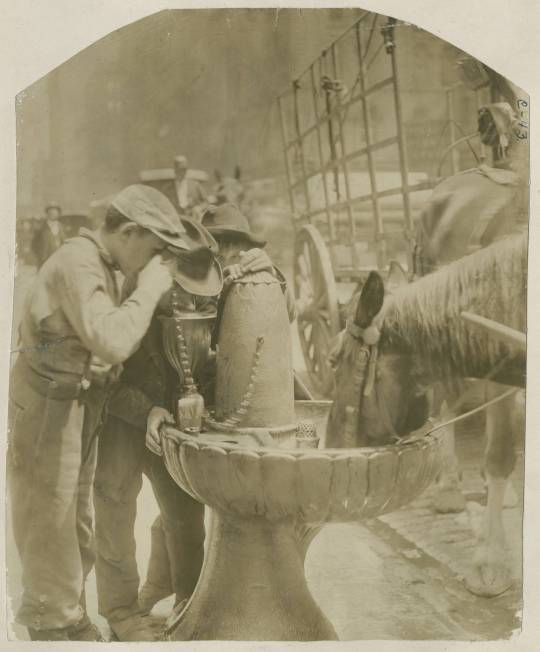
Chicago History Museum
Use of shared cups did not die out until the early 1900s.
Remembering forgotten fountains
Chicago has more than 100 outdoor, public fountains, but more than that have come and gone. Many of these forgotten fountains—from the big shots to the little squirts—have interesting or amusing stories to tell. The massive Buffalo Fountain in Ravenswood, a very large fountain in a tiny park, featured three enormous buffalo heads facing outward. It was Installed in the 0.07-acre park at Sunnyside, California, and Manor avenues in 1918, and by 1941 the sixteen-foot-tall concrete fountain had crumbled. Most locals don’t know that the name of their cherished park comes from the lost and forgotten Buffalo Fountain.

Chicago Park District, Special Collections
This large fountain gave the name to tiny Buffalo Park at California and Sunnyside avenues.
The 1890 Yerkes Electric Fountain in Lincoln Park was ahead of its time, combining water and electric lights, and foreshadowing both the World’s Columbian Exposition of 1893 and Buckingham Fountain. The spectacular waterworks attracted tens of thousands to Lincoln Park. The dazzling seven-foot-tall piece was 120 feet in diameter. It had two rings of jets shooting water inward and one central jet shooting water as high as 110 feet, creating a pyramid effect. The ruthless Charles Tyson Yerkes, an archetypical nineteenth century robber baron who built much of the Chicago ”L,” funded the fountain in an attempt to burnish his poor reputation with the public, press and politicians.
Everyone gushed over the popular attraction. An 1895 history of Chicago said, “The projection of strong electric light through colored glass on falling water…renders Lincoln Park one of the most favored pleasure grounds in the country.” A reporter compared Yerkes to Caesar, who created “public spectacles of such magnificence that he became at once the people’s idol.” The Electric Fountain didn’t make Yerkes an idol or even do much to improve the negative views of him. People realized the best way to get to the fountain was to ride Yerkes’ cable car line to Lincoln Park, prompting the Tribune to note, “Thousands dropped nickels into the importunate hands of Yerkes’ conductors for the sake of looking at Yerkes’ ‘gift.’”
Yerkes was more or less run out of town in 1899 by disgruntled colleagues, dissatisfied transit riders, and a hostile press. This left no one to advocate for his Electric Fountain or pay for its expensive upkeep. Neglected and vandalized, it was removed in 1908.
Many fountains decorated Chicago’s two world fairs. The Columbian Fountain was a focal point of the 1893 World’s Columbian Exposition. Dominating the central Court of Honor, this magnificent piece featured Columbia atop the Barge of State, heralded by Fame, oared by the Arts and Industries, and guided by Time at the helm—all of which was surrounded by numerous water jets. Later, the 1933-34 Century of Progress featured many waterworks, but the Exposition Fountain in the North Lagoon stole the show. With a flow of 68,000 gallons a minute, it was billed as the largest fountain ever built. It included a 570-foot-long series of ostrich plume jets culminating in a dome of water more than 75 feet wide and 40 feet high.
American Architect, 1934
The Century of Progress’ Cascade of the Months was built as a permanent installation and survived for several decades after the fair. Located in front of the Adler Planetarium, it was the focus of a 500-foot-long, 93-foot-wide esplanade that the National Terrazzo and Mosaic Association built as its exhibit for the fair.

Curt Teich Postcard Archives
The Cascade of the Months was built in front of the Adler Planetarium as part of the Centruy of Progress. It featured one colorful terrazzo panel per month.
One of Chicago’s most distinctive lost fountains, this masterpiece featured twelve colorful ground-level terrazzo panels, one for each month. A thin sheet of water flowed over them and accentuated the shimmering effect of the bright, underlying terrazzo, which is composed of ground marble, glass, stone, or metal mixed with a binder, such as cement or epoxy. The mixture is then poured into patterns outlined by metal strips, allowed to harden, and polished. With the Cascade of the Months, craftsmen used more than 50 colors of paint and marble chips in a binder of white portland cement. The work sparkled, at least initially.
After the fair, the fountain fell into disrepair. By 1968 the work was in a deplorable condition. The planetarium removed it circa 1970 during a building expansion project. Although Chicago’s freeze/thaw cycle can be merciless, Richard Bruns, executive director of the association, said, “The planetarium’s installation could have been maintained because we have exterior installations from the early 1900s that are still in good shape.” Those who remember the bright terrazzo panels covered with flowing water must miss this “glistening magic carpet of color harmony.”
Riverview Park boasted Creation, a dazzling display of water with a highly decorated wall symbolizing creation as a backdrop.
Architectural Forum, 1930
In a few cases, physical remnants of lost fountains poke out, hidden in plain sight. The defunct Victor Lawson Memorial Fountain on the east side of the former Chicago Daily News Building along the Chicago River at 400 W. Madison Street is an empty shell. (Lawson was the longtime owner and editor of the newspaper.) This once mighty fountain had an unusual design: three large portals about 25 feet high gushed water into a semicircular basin near ground level. It has not run for decades and unlikely to ever operate again.

Art Institute of Chicago
The once mighty Victor Lawson Memorial Fountain on the east side of the former Chicago Daily News Building along the Chicago River is just an empty shell.
When they were built in 1929, the Daily News Building, plaza, and fountain made big news. “Their beauty will be massive, symmetrical, thoroughly American, and modern,” raved the New York Times. Especially important was the way the edifice embraced the river, decades before such a practice was required. In fact, the building was Chicago’s first significant modern commercial skyscraper to face the river, opening its arms to the river with its 400-foot-wide plaza, highlighted by its commanding fountain.
The Gateway Park Fountain, a beloved water spectacle in front of Navy Pier, lasted only twenty years. When it opened in 1995, Chicago celebrated its fun interactive design. “Watch out Buckingham Fountain,” shouted a Tribune article that went on to quote a tourist saying, “I’ve never seen anything like it.”
The computer-programmed water wonder featured a large black granite block with more than twenty “skyrockets” that shot water as high as 100 feet. Surrounding the block, 200 “nanoshooters” buried at ground level delivered unpredictable bursts of water one-inch to six-feet high in fast-acting sequences. Kids chased around the dancing spurts of water and clung to the five-foot-high granite block to catch water cascading over its sides.
The fountain “explodes, with a dozen plumes of water high into the sky,” wrote the Tribune’s Rick Kogan. “Water shoots from holes in the pavement. Children giggle and get wet. Mothers and fathers sit there, watching in wonder the power and beauty of the liquid fireworks.”
Nevertheless, in 2016 the Gateway Park Fountain was demolished. The good news is that it was immediately replaced with a similar waterworks. The Polk Bros Foundation donated $20 million to remake the 13-acre Gateway Park—and rename it Polk Bros Park. The work included the new 75-foot-diameter Polk Bros Park Fountain. This interactive waterworks is equipped with more than 250 programmable water jets. The illuminated, multicolored piece “mimics the natural movements of waves, schools of fish or flocks of birds,” according to its designer. In the winter the area can be transformed into an ice-skating rink.
Finally, parts of fountains that disappear can be repurposed in a different time and place. Such was the case with Charitas. The eight-foot-tall bronze statue of Charitas debuted in 1922 as part of a fountain featuring a wide basin and water jets. It stood atop a large, square pedestal at one end of the basin. Ida McClelland Stout won a Daily News competition to sculpt the statue, which depicts a woman holding two children and symbolizes charity to underprivileged youth. Its original placement in Lincoln Park west of the Daily News Fresh Air Sanitarium—a health center that accommodated more than 30,000 children a summer during its peak—recognized the humanitarian work done there. (“Charitas” comes from Greek for charity.)

Chicago History Museum
Charitas stood in a fountain along the lakefront near Fullerton Avenue until the 1930s, when it was moved to the Garfield Park Conservatory. In 2016 it was returned to its original location, but as a statue on a pedestal rather than as a fountain.
When work on the northbound lanes of Lake Shore Drive in the late 1930s required removal of the fountain and a portion of the sanitarium (now the Theater on the Lake), the park district moved the statue to the Garfield Park Conservatory. Regrettably, the conservatory painted the bronze statue white to match Pastoral and Idyl, two white marble figures sculpted by Lorado Taft on display there. In the 1990s expert conservationist Andrzej Dajnowski removed the paint from and restored Charitas, but in 2001 the conservatory moved the statue into storage to make room for its blockbuster Dale Chihuly exhibit, “A Garden of Glass.” The statue remained in storage, even after Chihuly’s exhibit closed the following year. “No charity for Charitas,” said the Sun-Times in 2003.
In 2016 the park district reinstated this lovely statue south of the Theater on the Lake, near where it originally stood. Although no water bubbles around Charitas, Stout’s statue has been returned to its original pedestal, which during the intervening years held the bust of George Solti in front of the Lincoln Park Conservatory.
Endnotes
This article was last updated on Saturday, June 10th, 2017 at 5:54 pm.

Source: https://forgottenchicago.com/features/chicagos-forgotten-fountains/
0 notes
Text
Selling generic Viagra, Rogaine to Instagram crowd – over the phone
Every man in Dylan Nelson’s family is bald. His dad, uncle and both grandfathers: all hairless. The 28-year-old headhunter from Newport Beach, Calif., started suffering the same fate when he was 23. He tried Rogaine but found it pricey and ineffective. Then he saw a cheeky ad for Hims, a startup that sells mail-order kits of prescription drugs. Nelson asked his neighbour, a dermatologist, what she thought. The drugs Hims was offering were the same ones she prescribed to her patients but cheaper.
Two months in, they seem to be working. “I’ve been cutting my hair every 10 days,” Nelson said.
Hims is one of a crop of new direct-to-consumer, hipster-branded U.S. startups selling prescription drugs to men through the internet. But where others like Keeps or Roman focus on one health issue (hair loss and ED, respectively), Hims wants to build a brand that serves men with many different ailments, from erectile dysfunction to acne. Launched in November 2017, Hims makes it possible for men to get a prescription after a quick consultation with an online doctor. The meds are provided by a network of pharmacies and mailed out in discreet boxes.
Hims is riding a confluence of trends: the loosening of telemedicine laws in most U.S. states, the expiration of Pfizer’s Viagra monopoly and men’s growing willingness to talk about and pay for health and beauty. Andrew Dudum, Hims’s 29-year-old founder and chief executive officer, vows to create a $10-billion-plus health-care company. “We’re the front door of the doctor’s office,” he said. “We are completely different from anything in the health-care system.”
It’s a bold plan, but Dudum and his team of disrupters will have to tread carefully. After all, they aren’t selling mattresses or razors. They’re selling prescription drugs with potential side effects. And some experts say telemedicine, a global industry worth an estimated US$19 billion that’s credited with bringing health care to underserved populations, could make it easier for people to get prescriptions that aren’t warranted.
Lindsey Slaby, a marketing consultant who’s done work for Target Corp., Equinox and Microsoft Corp., applauds Hims for trying to make it easier for men to talk about hair loss, ED and other ailments. But Slaby said the company’s sometimes glib marketing could gloss over the downsides of pill popping. “You just don’t feel like you’re seeing a lot of the fine print,” she said.
Dudum doesn’t have a medical background. He’s your archetypal San Francisco startup guy: direct, optimistic and oozing California good vibes. At Wharton School, he was in the venture capital club. He’s best-known in tech circles for founding Atomic, a small venture firm that starts its own companies and is backed by Silicon Valley titans Peter Thiel and Marc Andreessen.
Dudum had been researching men’s health, looking for a way into the market, when one night over dinner his sister berated him about his nonexistent skin-care regime. She grabbed his credit card and bought $300 worth of “French stuff” on the spot. The cost and the confusion over what exactly he was getting pushed Dudum to start Hims as a transparent, one-stop shop for men who don’t want to deal with late-night Google searches or sheepish trips to the store or doctor.
Hims has raised US$97 million from such investors as Institutional Venture Partners, Forerunner Ventures and Josh Kushner’s Thrive Capital. The latest round valued the company at US$500 million, according to data firm PitchBook. Hims said it pulled in US$1 million in revenue in its first week, a rate that’s only grown since then. Do the math and that’s US$32 million in eight months, a pretty decent run rate for such a young startup. Dudum said signing up two million regular customers would generate almost $1 billion in recurring revenue.
Besides ED and hair-growth drugs, Hims sells skin-care products, a cold-sore remedy, scented candles, matches and a limited selection of apparel. (“It’s a sweater. It keeps you warm.”) The meds come in chic packaging, and the creams and shampoos lack the off-putting medicinal smell of your father’s foot ointment.
The key to Hims’s success so far is the availability of its two main drugs in generic form. A Hims prescription of finasteride, a version of Merck & Co. Inc.’s hair-loss drug Propecia, costs about US$30 a month, less than what most pharmacies sell it for. For US$44 a month, Hims bundles in medicated shampoo and minoxidil drops, which sell for US$30 over the counter at CVS.
The company is essentially building a brand around drugs that Pfizer (with Viagra) and Merck spent years and hundreds of millions of dollars marketing. Targeting men in their 20s and 30s, Hims advertising leans sophomoric. Cheeky shots of drooping cacti and eggplants fill New York subway stations, urinals, podcasts, sports arenas and are on TV during the NBA finals. They’re also all over Instagram.
The U.S. Food and Drug Administration requires ads making a specific claim about a drug’s benefit to disclose possible side effects. Hims said it’s selling a brand, not a specific drug, and doesn’t include the boilerplate language in its ads (which would clunk up the presentation). An FDA spokeswoman declined to comment.
But some experts wonder if finasteride should be prescribed to healthy, young men. The drug was originally developed to help mostly older men shrink enlarged prostates. When it was also found to help regrow hair, finasteride was marketed to younger men (though older ones including Donald Trump still take it, too). Recent studies suggest that finasteride can make some men have trouble ejaculating or maintaining an erection. A 2017 study found 1.4 per cent of men got ED, some of whom had it for 3.5 years or more after they stopped taking finasteride. Among younger men, those who took the drug for extended periods of time had a much higher risk of ED than those who didn’t.
Nelson Novick, a dermatology professor at the Icahn School of Medicine at Mount Sinai New York, said that because hair loss isn’t life-threatening, it’s not worth the risk prescribing finasteride — especially to young men. “It’s not some guy in his 60s, 70s and 80s where it may not make that much of a substantive difference,” he said. “Now you have young men who may end up with permanent dysfunction.” He has stopped prescribing it.
The ease of getting a prescription through Hims also worries some experts. Patients fill out a health questionnaire that goes to one of a network of 124 doctors. Those patients suffering from hair loss take a few snapshots of their head. The physician might send a few follow-up questions by email, but there’s no need for a video or phone call. (Doctors are paid depending on the amount of time they spend seeing patients on the platform, regardless of whether they prescribe medication or not.)
The process is perfect for busy, potentially shy Hims customers, but skipping a real doctor-patient conversation runs the risk of missing important details. A 2016 study found physicians were less likely to order followup tests when working over the internet than in person. Telemedicine also gives people yet another excuse to skip regular checkups.
“They’re trying to target these fairly universal problems and either help people who wouldn’t get care otherwise or make it easier for people to receive the care that they need,” said Arash Mostaghimi, a dermatology professor at Harvard-affiliated Brigham and Women’s Hospital who advises Hims. He argues that startups like Hims will encourage men in their 20s and 30s who typically avoid doctors to plug into the health-care system.
from Financial Post https://ift.tt/2LaqlvB via IFTTT Blogger Mortgage Tumblr Mortgage Evernote Mortgage Wordpress Mortgage href="https://www.diigo.com/user/gelsi11">Diigo Mortgage
0 notes
Text
Canada Road 5
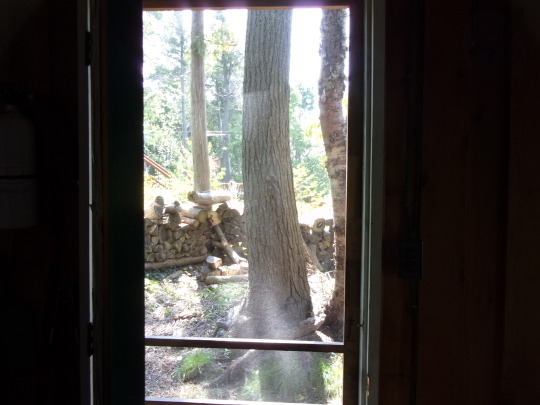
AUGUST 23
Between Goderich and Kincardine,
Lake Huron
Great Lakes
Ontario
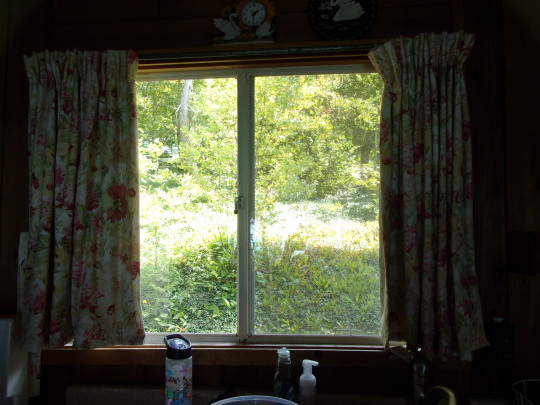
Can’t see the Sunset for cloud
Today we had rain and thunder storms. The lake was completely calm early this morning in fact it was the flattest I have ever seen it and I thought ah, I will be able to swim today. But first I sat down to meditate by the lake, using a red plastic chair, sheltered under an awning and fellow swimmer swam out so far he was just a dot on the lake. Then the slight drizzle got more intense and as he left the lakeside the rain began in earnest. First heavy and then in a trice torrential and although I tried to stay and meditate, the rain was coming in so I moved farther back. Then as it poured a drip began from the awning right onto my head and my hood was rapidly wet, so I gave up and took the path back up to the cottage and went and meditated peacefully in my room.

Later that morning watching the thunder that rolled in and counting the seconds between lightning and thunder I saw white lightning strike the lake at the horizon straight from the thunder clouds. I wouldn’t have missed it. Lightning on Lake Huron!
The fields were drenched.
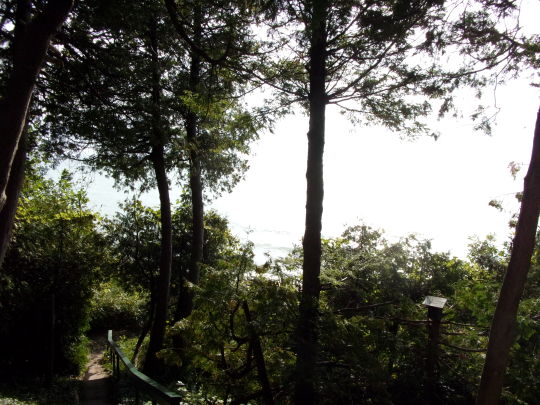
Next day:
It’s raining on Lake Huron. The washing and swimsuits and towels on the line strung between two huge pine trees is not getting any drier.
Its evening now and yesterday I achieved a best: I won my first ever game of five pin bowling. I beat everyone, much to everyone’s amazement. It was simply a great feeling to be the best at something, no matter how insignificant or how transitory. It was a laugh. I just remembered my Dad bowling beautifully almost making it graceful and tried to follow suit and it seemed to work somehow.
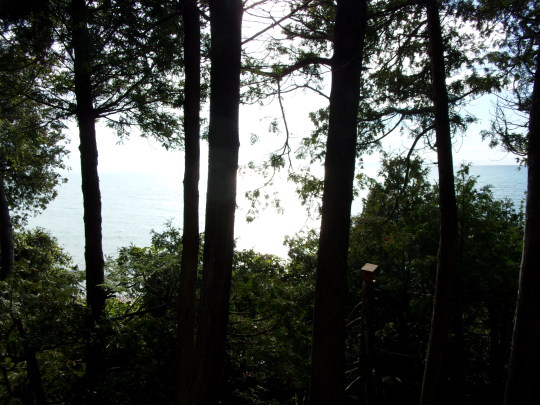
Then I went to see a piece of wonderful Canadian theatre at a very small place called Blyth which when it is not performing outdoors performs in the local town hall which looks like a museum or church or a cross between, a beautiful piece of architecture.

Today’s swim was good, the water is fresh but manageable, but I was able to swim up and down without being knocked over by the waves or swept off my feet by the current. It takes some time to get used to swimming on one of the Great Lakes.
Today I went for a walk up the dirt road that leads in here through farmer’s fields that stretch for as far as you can see on either side. They grow vegetable crops but without hedges or fences just a bunch of trees might signify the end of one field. Either side of the track are a wide selection of beautiful summer flowers. We collected one of each kind only. There was the golden rod and the meadowsweet, black- eyed-susan, toadflax, vetch, purple thistle, pink clover, scabious and a blue flower and a shaking grass. They were in the most beautiful clumps almost painted on and in such delicacy. So much colour.
The sun is hiding tonight but the lake is flat with no waves.

0 notes
Text
Ride the Rialto
ITALY JOURNAL 3
Blog by Lynne Pearl
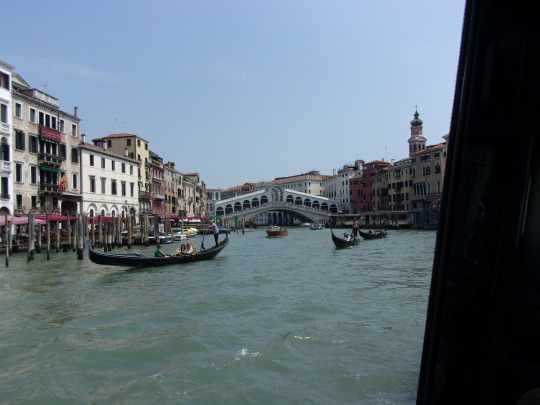
Arsenale stop on Colonna,
Garibaldi street
Venice.
10.15 pm
Friday June 9 23
Yesterday we were met at the water taxi stop at Arsenale by our host. We were shown to our place which was adequate, more than as we were in Venice and it felt amazing. The air is so clean as you are surrounded by sea water and sunlight. The light falls on all the beautiful colours around.
What is it like to be in a city without cars? Just try Venice, there are no cars and suddenly things become more manageable and slower, much slower. It is heaven. There are boats everywhere.
Now it’s getting hotter, which is great. This morning we began with fresh vegetables on a boat, like a grocery shop on water. So, we were able to buy peaches, green beans, carrots, zucchini, tomatoes all very fresh, off a boat. How wonderful, to have vegetables so fresh and the shop is a boat.
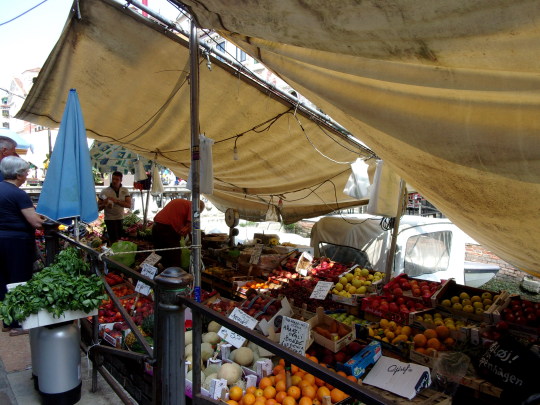
Then the day began by catching the number 5 boat up the Grand Canal, destination the Ca d’Oro. But first we had to pass the world and everything beautiful by taking a boat on a sunny day in June along the Grand Canal in Venice, stopping but not getting off at just about all the places in history, from a Venetian point of view and much of the world too. They had an enormous number of ships travelling the known and unknown world in search of luxury goods, spices and silks for the market in Europe.
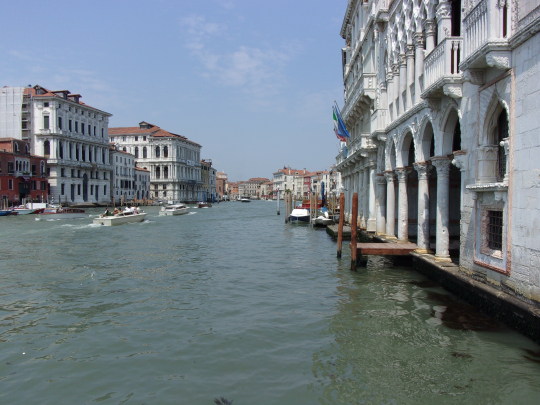
We passed St Mark’s Square where one can see the domes of the church and the wonderful pink and white palaces, the striped posts, the gondolas and the young men who drive them in their traditional black and white striped shirts. There was huge church, white and with huge domes, topped with a Christ in majesty with all the stars around him. The sea water was turquoise blue. As one waits for the water taxi at the pontoon, by the water’s edge it was heaving. The boats pull alongside and people just file off and more get on. There’s push chairs and babies, dogs, and life.

The Rialto is just magnificent, bridges are ornate and white, the buildings decorated and a deep shade of pink brick, everywhere is beauty and the sea with small boats babbling about and somehow nothing crashes into anything else. The sight of the Rialto in real life, not a painting, or a chocolate box and teeming with life was one of my favourite moments, teeming with life, busy with boats and people.

At one point while in the Ca d’Oro we heard a siren and looked out over the balcony at a yellow boat speeding through the traffic, it was a water ambulance, racing to rescue someone, somewhere in this city without cars. When cars aren’t there, the people are friendlier, can stop and talk on the street, in the middle of the road.
www.lynnepearl.com
https://www.goodreads.com/author/show/7796332.Lynne_Pearl
https://www.amazon.co.uk/Thiel-One-Foot-Front-Other-ebook/dp/B00GLNTCR2
https://www.amazon.co.uk/Road-Trip-River-Voices-Liminal-ebook/dp/B00HAG1Q2I

1 note
·
View note
Text
The Thousand Guinea Oak

THE THOUSAND GUINEA OAK
Blog by Lynne Pearl
www.lynnepearl.com
July 23
We went to the Vyne and the house and gardens were lovely, but there was also the Thousand Guinea Oak, which is still there, in good dark green leaf, six hundred and fifty years old. It was safe, given special food and tested for atypical winds. Through time it has hollowed out and is now home for many creatures.
It is very tall with plenty of dark green leaf, an indication of health. At 650 years it was tiny sprout in 1373, so most of our history it has been there, watching us grow up. It has been our friend. (Remember the Ents in ‘Lord of the Rings?’) https://tolkiengateway.net/wiki/Ents
The very old trees survive in the Home Counties of the UK as the climate is kinder than in other parts of the UK. This one is on a National Trust estate in Hants called ‘The Vyne.’ https://www.nationaltrust.org.uk/visit/hampshire/the-vyne

https://www.goodreads.com/author/show/7796332.Lynne_Pearl
https://www.amazon.co.uk/Thiel-One-Foot-Front-Other-ebook/dp/B00GLNTCR2
https://www.amazon.co.uk/s?k=lynne+pearl+road+tripriver+voices&i=digital-text&crid=2MG1UTW6MAFTT&sprefix=lynne+pearl+road+tripriver+voices%2Cdigital-text%2C82&ref=nb_sb_noss
1 note
·
View note
Text
Okehampton Station Re-opened
Blog by Susie Bedford
(Pen name, writing poetry and novels is Lynne Pearl)
Website https:lynnepearl.com
April 23

There always was this old piece of track left behind after the 60’s cuts. Somehow this little piece of track between Crediton and Okehampton was still there. The line to Barnstaple stayed in full service, but the piece going to Okehampton was only open on Sundays in the season for tourists and now it’s back, for all of us to use. Is it a sign of the times, that we need more public transport than ever, not less if we are to reduce our reliance on the motor car which will be eclipsed eventually. There is still a line between Plymouth and Gunnislake and it’s only a short piece of track necessary to join the Meldon quarry to Gunnislake and that would re -open an inland route across Devon that doesn’t involve Dawlish, the sea and storms in winter. It’s so close. There is a viaduct outside Tavistock that has become a cycle route but it would be grand to link up the communities by rail.
There is also a route between Starcross via Cofton but there is the matter of a hill in the way. This is the case with Devon, it’s amazing we got a railway when you consider hills that are everywhere and, the mass of Dartmoor, our centre and beating heart.
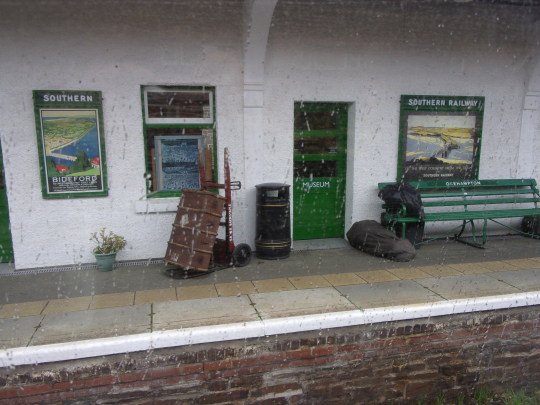
But we have a line opened full time for all from Exeter all the way through to Okehampton. It has a real station again, not a picture postcard but an active service line that takes people from the heart of Dartmoor and the beaches of North Cornwall back to the beating heart of civilisation via a train. It can take them home to jobs and all that entails in the South and South East of England. It’s doable now and the community must be glad.
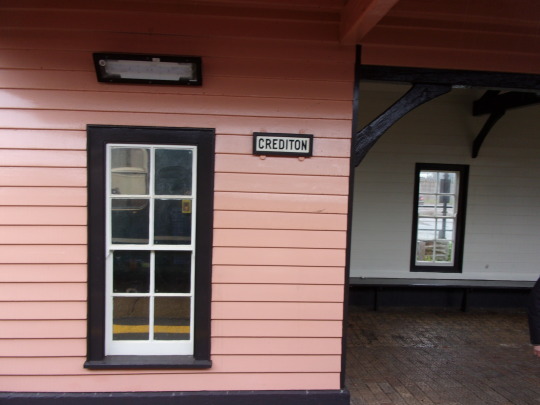
The new-old line goes through Crediton where the track is single line and the signal box ensures the line is safe for trains to proceed. There is a level crossing gate and beside the track there are horses in the field with may bushes in flower at this time of year.

The staff on this line are friendly. It’s almost as if they are chosen for their people skills, they are kind and patient, with time to make sure the journey is pleasant. This is wonderful, a truly social railway. This line seems to have more bridges than I have ever seen, magnificent stone bridges to carry lanes over the line that runs between farms.
At this time of year there are fields of rapeseed in flower, a yellow so bright it looks painted on. Evidently the bees get drunk on the rapeseed it makes them dizzy there is an abundance. We pass blue tractors, a collection of them, and we are so close to the cowsheds you can see the cows waiting.
There’s a viaduct at Holsworthy that is now a bike track. This train reconnects Bude with the world. Imagine there used to be a train all the way to Bude, my parents took it on their honeymoon many years ago. A way of life nearly, not quite forgotten, Bude is the town that is the farthest away from a mainline station until the railway opened again in Okehampton.

We hope this is the way forward for us all to connect and keep our communities alive.
PS I wrote a poem in the carriage en route…
THE NEW OLD LINE
Deep green,
Rolling wet hills
As we approach small town Crediton.
There’s nineteen thirties platform here...
(and so one...)
www.lynnepearl.com
https://www.goodreads.com/author/show/7796332.Lynne_Pearl
https://www.amazon.co.uk/Thiel-One-Foot-Front-Other-ebook/dp/B00GLNTCR2
0 notes
Text
SPRING IN BERKSHIRE

SPRING DOUAI
Blog by Susie Bedford
(Pen name, writing poetry and novels is Lynne Pearl)
Website https:lynnepearl.com
April 23

It is Spring in Berkshire and we’re high up above the main Bath road on a ridge that overlooks the railway and everything else. Up here they breed race horses that go to Newbury and race for the world. My Dad loved the horses and so I did too, it was the kind of enthusiasm that was catching. I never rode but I loved the horses, the race and everything to do with it. Today I see that there is Point to Point announced for April 26 Sunday across fields high above the sea. We used to go too, but the first love is the race with the jockeys’ colours the wonderful names of the horses and the specialty of the breeder. There was a book on the form and the wonderful horses for the year. It was all completely infectious. We would go and sit outside the racing area with a picnic and the sound of the horses racing was in background, and the crowds cheering.

But today it was quieter, it was Spring coming so slowly to Berkshire and the country after a cold long time. So when you see a spangle of hawthorn blossom on a dark hedge you are excited because that means hope, hope springing up again, that this cold can change, in fact everything can change, so let’s keep going, you never know what might be around the corner. In fact, the Hawthorne is the first. I remember the image from Cicely Barker’s flower fairies of the trees, the image for Spring, Hawthorne announcing it.
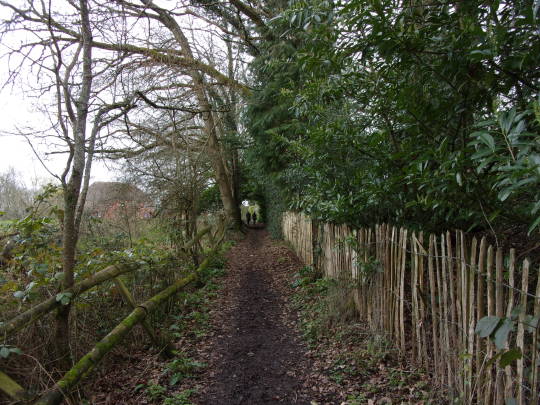
This is a Spring walk in Berks and even in the woods there are no bluebells yet. I know exactly where the bluebells should come in the woods, I have seen them year after year. They aren’t there yet, just this misty hawthorne blossom. There are bridle ways here, daffodils beside them and that’s testament to how many horses are up here on the ridge. They don’t have footpaths, they have bridle paths, so you do listen out for the jingle of the bridle and that sound like no other, of hooves on a muddy path, a thud that comes out of the past, our past from before we thought of cars. But the horses are still here so there are paths for them.

The trees here look bigger than anywhere else. Is the weather kinder, better, is the soil richer, or is it that there is a different species up here. The branches reach to the sky and obscure the skyline with their blooming upwards.

The rhododendron is beginning here too. They’re splendid on Exmoor, a statement of glory, waiting and never, not ever giving up because the best is yet to come. Here’s a hidden bush beside an old school that is long quiet, it had been a hospital long ago up here where the air is good.

I find violets, tiny under the pine tree that houses the rooks by the main drive. They are just tiny dots, and then a find a cultivated rhododendron bus like handkerchiefs, unlike anything else in nature. There are trees here whose blossoms spray upwards like the sea foam, and there are fruiting trees that need the bees to come.

There is also an Old Man Willow here that is just beginning, as if he heard the notes of Spring and decided to put a push on but then hesitated and is now waiting for a better moment. So the leaves are very gently there, of the palest green. Underneath is the perfect bench for looking at the tiny fronds that are the beginning, just like us.

www.lynnepearl.com
https://www.amazon.co.uk/Thiel-One-Foot-Front-Other-ebook/dp/B00GLNTCR2
https://www.goodreads.com/author/show/7796332.Lynne_Pearl
0 notes
Text
Ships On the Skyline, Teignmouth

SHIPS ON THE SKYLINE, TEIGNMOUTH BLOG May 21 By Lynne Pearl
This is not the Caribbean though you may be forgiven for thinking it is, but there are three cruise ships, big ones in the bay, but this is Torbay on the South Devon coast. These ships have been there all winter, visitors from warmer climes. But seeing as no one is going on a cruise for the moment, the cruise ships have to go somewhere so they have come to South Devon for the duration of the pandemic. Occasionally they toot to one another and to us watching from the shore, there are even tours around the ships, sea trips around the bay for visitors to look at these behemoths. They are floating hotels that we usually never see, our harbours and ports are not big enough for them, except for Falmouth on the Fal.
They are empty of guests, only crew on board but that takes about a hundred. Occasionally they start them up just to turn the engine over and go to France and back. We have even had the royal QE2 in our bay with her regal red and black funnel that marks her out from the other ships. One of the shapes on the horizon is actually an island but you can't tell the difference at just a glance or in mist, or twilight or a moonlit night.
This is like the horizon when we have had when other shipping disasters have happened in the area. There was the Torrey Canyon that split oil for many miles and was a disaster for the birds and fish. Then more recently at Ladram Bay there was a container ship blown off course that wrecked and there were motorcycle parts and china washed up on the beach.
One day our skyline will sail away, but will life go back to normal again?

Skyline is important too symbolically, it is where we look to for hope and for change..I used it in one of my novels Thiel 3 “Sea Journeys,” when an old sailor looks far away to the horizon towards his future.
He is talking about a voyage he cannot make as his sailing is over, but he advises Thiel, the hero, to take the ship and sail on further in his search for a cure for the young child, Shiney.
QUOTED FROM THIEL 3 'SEA JOURNEYS':
“Hallo”, said Thiel and Ned turned to look at him. “Morning”, he said, nodding and looking Thiel up and down, not missing Shiney’s presence at his side. “Hallo, missy,” he said to her. From Thiel’s side she looked straight into his sea blue eyes. “Ye’re a pretty little one,” said Ned. “And what can I do for you two, this morning?” he asked looking up at Thiel. “Here sit awhile,” he added indicating a pile of rope for Thiel and nets warmed by the sun for Shiney. Thiel seated himself and in no time at all was telling his and Shiney’s story from the beginning, how he had found her, brought her up and her increasing sickness in the winter months (and when it came to some of this he spoke quietly.) He told Ned how old Miss Ashburton at Ashburton’s Bookstore in the community had been treated by a healer when she was a girl, how his search for one of them had found nothing and there were no more leads. Where this coast line met the sea, where the mountain moors touched their feet to the sea was the end of his trail. Ned listened and looked out to sea all the time, his eye on the horizon where sea met sky. He seemed only to half listen whilst the other half of him was far away beyond that point where the eye could reach. But he nodded from time to time in Thiel’s story, to encourage him and sucked hard on his pipe at the difficult parts. Thiel’s story was at an end and it too sat at Ned’s feet, waiting. Ned continued to look out to sea and suck on his pipe. Thiel sat silent and stared at the pile of nets between his feet. The only sound was that of the seagulls wheeling and calling up and down the red cliffs... “I did hear” said Ned, “Once when I was sailing the Folly Islands, of a healer... ‘You go, boy, ... Maybe you’ll find what you’re looking for, maybe not, but go. See it. You are young. I’d go with you in a moment, on a voyage like that, but my legs would never hold out.” He stamped the pebbles with a lame foot, “Damn them” and he cursed long and loud like a true sailor. When he fell silent he eyed the seagulls maliciously and seemed likely to say no more that day. Just when Thiel was beginning to move, Ned turned sharply to him, “Don’t you let those crooks in harbour rob you of your money, for the voyage. You give them half now and half on arrival, or else they’ll be putting you off on any island, the nearest, not where you’re bound for at all. Do that all along the way and you’ll be alright. And don’t talk, don’t talk to them around you. Keep your peace and answer no questions and you’ll arrive safe enough, not arousing curiosity.”
“Thank you Ned”, said Thiel. He wished he could give him something, but the one thing Ned wanted, to sail with them, Thiel could not give. “I’ll bring a cure for your legs,” he said eyes shining. “Yes, yes boy,” said Ned, not believing but not wishing to hurt his feelings and wishing it were possible anyway. “You do that”, and he turned to study the sea again intensely.

#https://www.amazon.co.uk/s?k=thiel+one+foot+in+front+of+the+other+lynne+pearl&crid=11MA2SBQIXRC&sprefix=thiel+one+foot+in+f%2Caps%2C217&ref=#lynne pearl#thiel one foot in front of the other#road trip river voices
1 note
·
View note
Text
WRITING DOGS IN FICTION Blog by Lynne Pearl
WRITING DOGS IN FICTION
Blog by Lynne Pearl April 8 21

When I was growing up I had a golden labrador called 'Prince' and we walked Devon come rain or shine from childhood right through to adulthood. He was my loyal companion so of course, I put him in a book too.
When I write fiction I often give my heroes a dog to accompany them on their adventures and their journeys and for me that always works. A dog is the perfect companion for a writer, they give the hero someone to talk to, so they do not feel so alone in the tasks they have to accomplish and the dog is not afraid where your average hero may be....quoted from 'Thiel One Foot in Front of the Other'....
He went down the three steps leading to the kitchen to find Heap, the family dog. Heap shambled out from the gloom of a dark corner. He pushed his head against Thiel’s hand so that they were joined. They had grown up together and knew one anothers' trials intimately. Thiel knew how hard it was for an animal of noble heart though ugly demeanour to refrain from growling ...
As Thiel knew Heap’s desire to bite in anger, so Heap knew through the touch of Thiel’s hand tonight deep unhappiness. The intricacies of reason he could read from the touch ...
Young man and dog pushed the door and went outside to the back garden beyond. It was nearly dark as they made their way around the side of the house to reach the Kurton road unseen from any windows...So the companions slipped through the hedge at the bottom of the vegetable garden and jumped soundlessly onto the road below.
Bent double below the height of the hedge and keeping in its shadow, Thiel loped along the road, followed by Heap padding through the grass at the roadside. His tall, boney frame with its' fronds of long hair was moving with an energy seldom used. The road curved slowly out of sight of the house and Thiel walked upright again. Heap joined him in the middle of the road. It was dark now and stars had begun to come out... (from 'Thiel: One Step in Front of the Other.')

POETRY ABOUT DOGS
Then there's writing poetry about dogs, they fit in there too, for me. The image of the dog just seems to be the perfect ift for so much. Like this :
TAMAR HOUSE SIGN
Washing on the line, Pink blanket, black T shirt, Dogs in the yard wondering, Beige short hair, Alsatian face, English sheepdog, head through gate, Inquiring of passing bus, Who? And where do you go? On the lane to Launceston, Waiting for the passing cars. ...
So that is what I say in 'Road Trip, River Voice', when I am travelling between Canada and Britain and back again.
Lynne Pearl, author, 'Road Trip River Voices' https://www.amazon.co.uk/Road-Trip-River-Voices-Liminal-ebook/dp/B00HAG1Q2I
Thiel:One Foot In Front of Another. https://www.amazon.co.uk/Thiel-One-Foot-Front-Other-ebook/dp/B00GLNTCR2
On Good Reads https://www.goodreads.com/author/show/7796332.Lynne_Pearl Available from Amazon
2 notes
·
View notes
Text
Autumn Sea Storms
AUTUMN BY THE COAST
Blog by Lynne Pearl
NOVEMBER 22

Autumn is about trees and leaves changing colour and I see plenty of that around here but also when you are really close to the sea there are other things that are happening too. Autumn means storms and the sea changing. It used to be that one would turn up with swimsuit and towel, ready to dive under the waves and swim as far as possible, even if it was only up and down the beach. Then watch the waves rise up and fall down and be lulled and rocked by their motion, surrounded by the saltiness of the sea that feels so refreshing and resourcing. It’s the tang of it on your bare skin. Then you are surrounded by sea weed, sand, rocks and pebbles. You have to watch where you put your feet down that you haven’t landed on the only sharp rock on your sandy beach.

And it is always different as the sun moves, the tides change, the wind is either still or pushing you this way and that, always with the eternal movement of the sea reaching the land and retreating again. a bit like life. We are always trying, doing and then we try again and then we try something else. Constant change and that’s maybe why the constant movement of the sea is so lulling, here is something big and it keeps going.

Now the sea is no longer inviting, it has changed moods, storms begin to roll in and when they arrive you don’t want to be anywhere near the coast. A storm will arrive with black clouds hanging over the sea, when it makes landfall it hits hard, stinging your face and the rain is driven hard into the pavement and roads. Beaches that only a few weeks ago were crowded, people were playing basketball in teams, are deserted and dark from lack of light, heavy clouds roll in and stay, bringing the autumnal storms.

Inland the leaves are falling and hang around the ground and pathways beside ancient Roman walls, some are yellow and gold, even a bright scarlet of trees usually grown on foreign shores, but in our autumn turn their glorious red, against the dark walls and bright yellow of other local trees.

After a few weeks of storms coming and going a long period of extreme weather sets in with storms out at sea. Then we see ships coming in towards our shores, sheltering from the extremes of life farther out at sea. If the weather gets really bad they can make a run for port, where they stand a chance. Walking on the sea front one can count the ships on the skyline. That’s not the island off the coast farther west, there are now seven ships on the horizon. They are different sizes and shapes, some are container ships and some other kinds.

During the pandemic we had cruise ships moored offshore, idle with no customers, just anchored somewhere out of the way. They stayed there all one winter right into the next Spring until we got used to them on the skyline and felt like they were our landmarks they had been there so long. But one day they did, one by one, day by day, begin to sail away. It meant they could take tourists again, hoping their business would come back after months of laying back, just turning the engines on for a bit, taking a drive up and down Lyme Bay or even to France but never going where they were destined to, Norway, the fjords, the Caribbean, but just keeping us company off the coast.

The cruise ships haven’t come back, these ships on our skyline are container ships that will resume their route and go on shortly, as soon as the weather improves. Winter brings us these transient visitors, there’s the leaves, the migrant birds and the storms at sea, the seasons change, it’s the time.
https://lynnepearl.com/
https://www.amazon.co.uk/Thiel-One-Foot-Front-Other-ebook/dp/B00GLNTCR2/
0 notes
Photo

“Entrepreneurship: you put one dumb foot in front of the other while the world throws bricks at your head.”
– Peter Thiel
Read more adversity quotes here: https://spreadgreatideas.org/quotes/quotes-adversity/
0 notes
Text
VISIT TO THE MID-DEVON SHOW
THE MID DEVON SHOW
BLOG JULY 30 21
By Lynne Pearl

We couldn’t have a show last year so this year’s was doubly special, we had twice as much to catch up on, more people to see, more animals to view, more stands to check out and more competitions to view. It was all there just as it always had been and it was a relief to see that life had gone on despite everything and the creativity and hard work that goes on on the farms in Mid Devon had not ceased but continued in full.
It was a good enough day, it wasn’t particularly hot but rather overcast and we all carried our brollies just in case, some even had their wellies. I daringly wore sandals and never actually got very wet, only slightly wet. It did cloud over and there was a very fine rain that didn’t even manage to make your clothes wet but just made your cheeks damp, which was kind of pleasant. I spent a lot of time in the churches’ tent drinking tea which was free if you wanted it, just watching the show go by. From under my awning I could see vintage buses from Devon General and a marquee with crafts of every sort, knitting, jewellery, pottery, glassware all manner of pretty things, perfect for presents.

The first tent I entered at the beginning of the day had the flower show. There were the most delicate arrangements, some wild flowers, some an arrangement of flowers in water but all wonderful to marvel at people’s patience and skill. Then there were the baking contests: sausage rolls, quiches, sponges, wedding cakes, biscuits. Beyond these were the home- made wines, of every colour imaginable, made from many sources. The country side skills were apparent everywhere.

One of my favourite marquees was a very warm, dim one with had all manner of poultry. There were water fowl, geese, cockerels of the softest colours, beige, black and white, fluffy white and alongside all the fowl were the rabbits of every size and shade. They had the most wonderful ears, some upright and some long and droopy. If you wanted to you could buy some of these wonderful creatures and start a new life, breeding the wonderful birds and rabbits.
I entered the showground from the field that serves as car park and immediately came across the antique tractors, loved and preserved by families over generations. I discovered a bright red one belonging to some long lost friends and spent a long time leaning on the tractor catching up on lost days and years. I also sent greetings to friends in common who weren’t at the show that day.

In the main arena were the majorettes dancing in formation while groups gathered in the surrounding tents talking, making deals, catching up, buying and selling. There were all the accountants and alongside them were the police forces. There was the local travel coach company, a holiday let business and everywhere there were free bags, pens samples and a holiday atmosphere. At the back of the showground was the concert stage and there I found a wonderful flute player, not a classical flute but a merry small pipe player who danced a jig in time with the music, which was the jolliest you have ever heard. He was accompanied by guitar and drum or accordian. The audience sat on haybales and quaffed beer and juice to the music and laughed at the misty rain that came and went.

There were the cows, the bulls and the sheep competitions with the judge deliberating on the merits of one pair of sheep over another, there were black sheep in a pen that refused to let me photograph them and finally the grace of the heavy horses, fewer than in previous years but dressed in their ribbons and brasses with their handlers in the costume of former times.
The surroundings were the grounds of Knightshayes Court with the ancient trees on the site, the hills in the distance and the green and yellow of the fields.
It was a grand show, with ideas for a whole year and food for thought for where to go next and what to do with the coming year…
https://www.goodreads.com/author/show/7796332.Lynne_Pearl
https://www.amazon.co.uk/s?k=thiel+one+foot+in+front+of+the+other+lynne+pearl&crid=2KOJQR9Z0RAPQ&sprefix=thiel+one+%2Caps%2C217&ref=nb_sb_ss_ts-doa-p_1_10
0 notes
Text
The Meadow
THE MEADOW

BLOG
JULY 21
By
Lynne Pearl

There is nothing like the smell of a meadow on a sunny day. I was walking from the Abbey grounds to where there had been Jacob’s sheep but now a meadow. Past the five bar gate stands a large, old willow with a seat ready to sit, think and pray. Then as far as the eye could see was the meadow with wild flowers of all colour and the bees buzzing. The Abbey hives are just the other side of the hedge beyond the chicken coop. Sitting in the shade from the heat of the day, the willow rustles in the breeze and the whole meadow moves as the tall grasses sway and undulate like a grassy sea.
It makes one ask how much of the countryside used to look like this? Probably swathes of it, and it is so hypnotically beautiful as it sways in the mid of the day. It is a loss of about 90%, and where did it go? The bees love this place, it is their kingdom.
Here they have many types of flowers, I get down on my knees in order to see everything. There is clover, speedwell, toadflax, bird’s foot trefoil, Queen Anne’s lace and many kinds of grasses. The colours are pink, blue, yellow and green everywhere. I just sit in it and it’s like going for a swim in the sea.

I wrote some poems about bees one summer holiday looking at the blackberry bushes in the lanes of Devon. The collection is called ‘Devon Heart.’ There are poems about the moor, villages, towns, seasons, Devon way of life, estuary, sea, leaving. It is a tribute to my home: occasionally we stray into Somerset, but mostly we are traveling in Devon. It’s a guidebook to Devon, take the bus, go slow, look.
You take the collection and read aloud sitting in the cafes, on beaches and then write your own beside it. Create a poetry of place and paint your love of life as you find it.

DEVON MID AFTERNOON
Butterflies crowd,
Flying from the hedges,
Brown wings
Settled against green blackberry leaves
And mauve blossom.
A cow with a star on her forehead
Gazes with dreamy eyes
And the sheep munch,
Woolly faced,
Staring in unison
And the white cow on the hillside
Stands ready to climb.
Beside the lane
Lie cottages, door ajar
With armchair ready
And a sleeping gnome
Lays against the cottage wall…
PERFUME
The sweet smell of newly mown hay,
Laying to dry in the field,
The riches of early summer,
A perfume to bottle,
Not of flowers,
But of grass….
I used this scenery, its’ people and landscape as a backdrop in the first ‘Thiel’ novel I wrote, ‘Thiel, On Foot in Front of the Other.’ Here I am quoting from that, describing scenery that was inspired by the rocks on Dartmoor, like Haytor, and the green meadows especially in the summer when crops are ripening.

‘All that evening he walked the lanes, his pace quickened by the tearing apart he felt within. He was being forced to tear himself from this land of deep traditions blessed with a mild, damp climate for a journey to a city whose way of life was inimical to all he had been born and bred to believe in. He did not want to leave this soft, countryside of rolling, green hills and grass as verdant as spring no matter what time of year.
The hedgerows clustered either side of him and he felt cradled in the abundance of nature, with their flowers and berries, the burrows of the animals and the stream that ran alongside in the earthy ditch. His dog, Heap padded beside him, pace quickened to match his masters, he grew more and more concerned for his beloved Master. Heap was only a dog however and could comfort with his prescence only and so the two walked the dreamy lanes for many hours together that beautiful night before returning home to a silent house.
…
He took the road through Kurton, saying goodbye to all that was familiar. He had walked through these lanes from when he was very small and they had become a part of how he made thoughts. The overhanging branches of trees, heavy with full sun season foliage were like thoughts of love that came into his mind, whilst the tall, enclosing hedges were the security of familiar ways of thinking and tradition. The ditch, often muddy and filled with rain water was his undercurrent of difficulty in thinking ideas clearly.
He passed by the outskirts of Kurton recognizing each house and cottage as he went by, but he did not go into the village. He preferred the road he always trod to Narn’s. He passed the “Barley Mow” and paused to gaze at the colourful signboard as it swung in full daylight.
Then later he stood and gazed long and hard at Narn’s little white house from the road. He did not enter as it was all locked up and Sara kept the key. It was better this way though, otherwise by entering he may never had been able to wrench himself away from the dearest of the past. It was definitely easier to leave when there was ill-will abroad, as he had done. So he stood and gazed and gazed, wishing and wishing, but life was determined not to be otherwise so he eventually let himself be pulled away by Heap tugging at his coat cuff. The little white house had a melancholy air, as if to say it would miss him dearly, but Thiel could not bear to see how much it would miss him and so left before it could pull his heart strings in.
Thiel had walked till very late to say goodbye to his country. It was a leave taking of the soil and the air that had nourished him. From now on he would have to be sufficient to himself without the support of familiar land that breathed as he breathed and whose tone of thought had coloured his thoughts from birth.’
© Lynne Pearl, 2021
Lynne Pearl, author, 'Road Trip River Voices' https://www.amazon.co.uk/Road-Trip-River-Voices-Liminal-ebook/dp/B00HAG1Q2I
Thiel:One Foot In Front of Another.' https://www.amazon.co.uk/s?k=Lynne+Pearl&i=digital-text&ref=nb_sb_noss
Available from Amazon
https://www.goodreads.com/author/show/7796332.Lynne_Pearl
0 notes